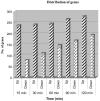Global analysis of heat shock response in Desulfovibrio vulgaris Hildenborough
- PMID: 16484192
- PMCID: PMC1426554
- DOI: 10.1128/JB.188.5.1817-1828.2006
Global analysis of heat shock response in Desulfovibrio vulgaris Hildenborough
Abstract
Desulfovibrio vulgaris Hildenborough belongs to a class of sulfate-reducing bacteria (SRB) and is found ubiquitously in nature. Given the importance of SRB-mediated reduction for bioremediation of metal ion contaminants, ongoing research on D. vulgaris has been in the direction of elucidating regulatory mechanisms for this organism under a variety of stress conditions. This work presents a global view of this organism's response to elevated growth temperature using whole-cell transcriptomics and proteomics tools. Transcriptional response (1.7-fold change or greater; Z >/= 1.5) ranged from 1,135 genes at 15 min to 1,463 genes at 120 min for a temperature up-shift of 13 degrees C from a growth temperature of 37 degrees C for this organism and suggested both direct and indirect modes of heat sensing. Clusters of orthologous group categories that were significantly affected included posttranslational modifications; protein turnover and chaperones (up-regulated); energy production and conversion (down-regulated), nucleotide transport, metabolism (down-regulated), and translation; ribosomal structure; and biogenesis (down-regulated). Analysis of the genome sequence revealed the presence of features of both negative and positive regulation which included the CIRCE element and promoter sequences corresponding to the alternate sigma factors sigma(32) and sigma(54). While mechanisms of heat shock control for some genes appeared to coincide with those established for Escherichia coli and Bacillus subtilis, the presence of unique control schemes for several other genes was also evident. Analysis of protein expression levels using differential in-gel electrophoresis suggested good agreement with transcriptional profiles of several heat shock proteins, including DnaK (DVU0811), HtpG (DVU2643), HtrA (DVU1468), and AhpC (DVU2247). The proteomics study also suggested the possibility of posttranslational modifications in the chaperones DnaK, AhpC, GroES (DVU1977), and GroEL (DVU1976) and also several periplasmic ABC transporters.
Figures


References
-
- Arsene, F., T. Tomoyasu, and B. Bukau. 2000. The heat shock response of Escherichia coli. Int. J. Food Microbiol. 55:3-9. - PubMed
-
- Bailey, T. L., and C. Elkan. 1994. Fitting a mixture model by expectation maximization to discover motifs in biopolymers. Proc. Int. Conf. Intell. Syst. Mol. Biol. 2:28-36. - PubMed
-
- Barton, L. L. 1995. Sulfate-reducing bacteria, vol. 8. Plenum Press, New York, N.Y.
Publication types
MeSH terms
Substances
LinkOut - more resources
Full Text Sources
Molecular Biology Databases
Research Materials

